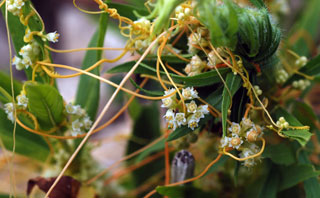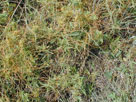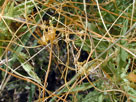FIELD DODDER
|
 |
| File Size: 77 KB |
|
|
|
Cuscuta pentagona Engelm.
|
| Woodson County, Kansas |
| Annual/Perennial |
| Height: Twining or climbing on other plants |
| Family: Convolvulaceae - Morning Glory Family |
| Flowering Period: July, August, September |
|
| Also Called: | | Five-angled dodder, witches' shoelaces, angel's-hair, strangle vine. | | Stems: | | Vine, twining, string-like, to 6.5 feet long, twining, less than 1/50 inch in diameter, pale brown, yellow or orange, glabrous. | | Leaves: | | Alternate, reduced to scales; appears leafless. | | Inflorescences: | | Loose clusters appearing along stem, compact, cyme-like, rarely obscuring stems. | | Flowers: | | Short-stalked; subtended by minute scale-like bracts, larger bracts similar in size and texture to sepals sometimes subtending small groups of flowers; calyx lobes 5, mostly enclosing corolla tube; corolla white, campanulate to somewhat urceolate, 1/16 to 1/12 inch long, 5-lobed; lobes spreading to recurved, narrowly-lanceolate, sharply pointed; stamens 5, shorter than lobes; styles 2, rarely 1; stigmas 2, capitate. | | Fruits: | | Capsule, globe-shaped, 1/16 to 1/12 inch long, 2-4-seeded, cupped at base by withering corolla; seeds brown, nearly spherical, ca. 1/20. | | Habitat: | | Shores of ponds, reservoirs, and lakes, floodplains, prairie ravines. | | Distribution: | | Throughout Kansas | | Origin: | | Native | | Reproduction: | | Seeds | | Toxicity: | | Infected hay can cause diarrhea in cattle and digestive tract irritation in horses. The pollen is toxic to bees. | | Forage Value: | | Ducks will eat the seeds. | | Uses: | | Native Americans crushed and boiled the stems to make a yellowish-orange dye used to color feathers. Pawnee girls would throw the vine behind them and if it re-attached to the host plant they would know their suitor was sincere. | | Comments: | | Field dodder forms tangled mats. Cuscuta from Arabic kuskut, a tangled wisp of hair and pentagona, five + angle.
In Kansas, field dodder has been found on a wider variety of hosts that any of our other dodders. It is documented on members of the Acanthaceae, Asteraceae, Balsaminaceae, Convolvulaceae, Euphorbiaceae, Fabaceae, Poaceae, and Verbenaceae.
Upon germinating, dodder seedlings are non-parasitic. The stem emerges from the seed first, followed by the root, which remains in contact with the endosperm until the nutrients are exhausted. Then the radicle emerges from the seed and penetrates the soil. As the stem elongates, it begins to swing in a circle, thus increasing its chances of coming in contact with a suitable host. If contact is made, the stem twines around the host and produces peg-like structures called haustoria that grow into the host's stem and tap into its water- and food-conducting tissues. After the first haustorial contacts are made, the dodder root dies, severing contact with the soil.
Dodders are difficult to identify, usually requiring flowers and mature fruits for accurate identification. |
|
| Field dodder |  | | 208 KB | | Stafford County, Kansas |
| | Field dodder |  | | 176 KB | | Stafford County, Kansas |
| | Field dodder |  | | 93 KB | | Woodson County, Kansas |
| | Field dodder |  | | 137 KB | | Woodson County, Kansas |
| | Field dodder |  | | 128 KB | | Stafford County, Kansas |
|
|
|
|
|
|
|